A wild flour is different than a starchy root. The Spurge Nettle has a starchy root that tastes like pasta but it does not lend itself to being processed into flour or starch. Below are many sources of flour or starch in five large categories… okay, six categories. Material you can bake by itself is referred to as a flour; material that is usually added to something else is referred to as a starch. While those definitions satisfy culinary needs they are not highly scientific and are used inconsistently. The energy required to get the material to a usable flour/starch stage has also been considered and in fact is a very limiting factor. A food that might be an outstanding wild edible can be listed as “poor” here because of the work required to make a “flour” out of it. This list is not definitive and will be added to and edited from time to time.
Outstanding
Amaranth is a grain that has been used for some 8,000 years. It’s rich in amino acids and higher in protein than most grains, some 16%. It was one of the staple foods of the Aztecs. Amaranth is usually added to other flours or materials and is gluten free. You can collect your own seeds and process them into flour or buy it at health food stores. The latter is a good idea to see if you like the flavor which is nutty and slightly peppery. While you can collect seeds from nearly any Amaranth, three species are commonly used: Amaranthus hypochondriacus, Amaranthus cruentus and Amaranthus caudatus. Four ounces of amaranth grain provides 100% of an adult’s daily protein need. It can be combined with wheat flour for yeast breads. Nutritionally 100 grams or about 3.5 ounces of Amaranth grain has 374 calories, 14.45 grams of protein 6.5 grams of fat, 15 grams of fiber, 4.2 mg of vitamin C, 153 mg calcium, 366 mg of potassium, 455 mg phosphorus, and 266 mg magnesium. You can collect it by putting the seed head in a bag and shaking the seed head. Amaranth grain does not have to be soaked before use.
Chenopodium, quinoa is another staple used like Amaranth. It is 11.2% moisture, 13.5% crude protein, 9.5% crude fibre, and 58.3% carbohydrate. Quinoa has a high proportion of D-xylose (120.0 mg in 100 gram sample) and maltose (101.0 mg in 100 gram sample) but is low in glucose (19.0 mg in 100 g sample) and fructose (19.6 mg in 100 g sample.) The protein content is as high as 18% and it contains a balance of amino acids. The seeds are high in saponins. Think of saponins as soap which is why the seeds need to be soaked. After soaking in two changes of water to reduce the saponins, quinoa can be used similar to rice, that is use twice as much water as grains when cooking. It has a light, fluffy texture with a slightly nutty taste. It’s not a true grain but is an excellent substitute for grain flour.
Good
Acorn flour has sustained millions for thousands of years, from the Ancient Greeks to the Japanese. During World War II Nipponese school children collected acorns daily in season to feed the nation. Today oak flour is still a common food in Korea and can be purchased in local markets. The main problem with acorn flour is collecting, shelling, and leaching the acorns. They have varying amounts of tannin which has to be removed though a few species have no tannins. Once the acid is removed and the nuts dried and ground, the flour is tasty and nutritious. It behaves more like corn starch than a cooking flour but can be used as flour. An ounce of acorn flour has 140 calories, 15 grams of carbs, 8 grams of fat (one of those saturated, 1.5 polyunsaturated) and 2 grams of protein. It also provides 1% of your daily need in calcium and 2% of iron, thiamine, riboflavin and zinc, 3% niacin and phosphorus, 5% folate, 5% magnesium, 6% vitamin B6. Acorns are gluten free and their oil can be used for cooking.
Barnyard Grass: Echinochloa crus-galli, winnowed seeds used as a staple grain. They can be parched, roasted, boiled, or ground into flour. Seeds can be popped like popcorn. In Japan Barnyard Grass seed is used to make macaroni and dumplings. Seeds are also roasted and used as a caffeine-less coffee substitute. In North America the Cocopa, Paiute and Tubatulabal tribes used it for food and stored it for winter use. The Yuma, however, really liked it. They pounded the seeds, winnowed them, ground them and made a meal and mush out of it. They also preferred to cook fish with the grain. It is not emergent but it likes its feet damp. Eastern Gamagrass can also be used.
Chia flour is not totally chia flour unless you make it yourself. The commercial version is made from brown rice flour and chia seeds (yes the ones you use for your Chia Pet.) Chia seeds are chock full of nutrition. They contain lots of Omega-3 fatty acids, calcium, fiber, and protein. Commercial chia flour, which is gluten free, can be used as a one to one replacement for wheat flour. Sift chia seed flour before using, use small pans when baking, and increase baking time by five percent.
Crabgrass would be listed as outstanding if it weren’t a big pain to dehusk. In parts of Africa crabgrass (Fonio) is a staple grain, and under cultivation it can produce a whopping 17 tons per acre. Crabgrass seed can be used as a flour, couscous or as a grain, such as in porridge or fermented for use in beer making. Now that’s another label I’d like to see: Crabgrass Beer. Crabgrass is not only nutritious but one of the world’s fastest growing cereals, producing edible seeds in six to eight weeks (excellent for short-summer northern climes.) It grows well in dry areas with poor soils and fantastically well in watered lawns. It’s a horrible weed if you own a lawn and a wonderful edible. Husking the small grains can be time-consuming, however. Traditional methods include pounding in a mortar with sand then separating the grain and sand (not advised.) Another method is “popping” seeds over a flame and then pounding said which produces a toasted grain. If you have a LOT of crabgrass you can even buy a crabgrass husking machine.
Crowfoot Grass is a staple grain in some areas of Africa used to make unleavened bread — Kisera — and often beer. It’s a very small grain, even smaller than amaranth or quinoa. Indeed, if it were larger it would be an outstanding source of flour. Fortunately it grows in larger colonies and is easy to harvest so from a “calories-in-calories-out” perspective it’s certainly worth your while. You can collect about two quarts an hour. Seed heads that are ready to give up seeds come off easily. I collect a large amount of seed heads then rub them over a colander to dislodge the seeds and sift out larger pieces. Then I winnow the rest. The grain is the size of sand but is fragile so it can easily be ground into grain that has a flavor of buckwheat. I usually mix it 50/50 with regular flour. There are some precautions so read the full article.
Wild Rice (Zizania aquatica) is not really a rice. It’s an aquatic grass seed which can be cooked and eaten as is. Wild Rice was important to the survival of many Native American tribes. A subsistence food, it’s very dark brown to black in color and is tan when ground into flour. It does require some collecting technique and a canoe or the like but from an energy in/out perspective it is certainly worth ones while. Wild rice flour is usually added to other flours or used to thicken dishes.
Yam flour (Dioscorea alata) is made from yams dried and ground. Yam flour works great in cookies and pie crusts. It is not good for sticky or doughy applications. As a flour it stores very well and is more than 5% fiber.
Acceptable
Arrowroot flour is closely related to Canna, below, and is used in similar ways. It is easy to digest and is one of the few wild flours with calcium ash in it. Most people know it know as a thickener for gravies and it’s neutral flavor and color when used as a thickener. Like Canna it’s from warm region plants whose roots have to be ground to release the non-gluten starch. Read work.
Canna flour has more starch in it than grain flours and has the highest swelling point, good for thickening. It is high in amylose and is slowly digested so it doesn’t spike blood glucose levels. Canna, however, suffers the same problem as cattails; it requires a lot of work to get the flour. Roots have to be dug up before the plant flowers, ground up, the starch settled out then dried. It is just easier to cook the root though that takes about 12 hours.
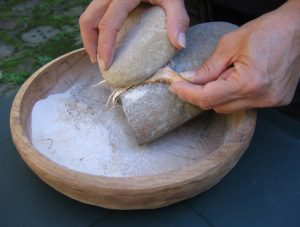
No plant produces more starch per acre than cattails.
Cattail flour has long history, from feeding primitive man to armies. The starch is trapped in fibers much like kudzu but is easier to get out than kudzu but still requires processing. There are several ways to extract it. Chopped roots (rhizomes actually) can be pounded in a mortar with some water, the fiber removed and the gloop dried. You can also hand crush the roots in a lot of water, let the starch settle and pour the water off slowly drying the starch. This essentially produces flour but requires time and many hands such as one would find in a camp or village. A different way is to just rub the rhizome with the back of a knife and eat the starch off the knife. However, it’s like eating plain flour. If I am on the move I prefer to take the rhizome with me. Later I will roast the root on coals then pull the cooked starch off the fibers with my teeth. It tastes like chestnut. Cattail, or as the Brits call it, the greater reed mace, is certainly prime as it is nearly impossible to misidentify, is very common, and an excellent source or calories. The down side is it grows in water so harvesting can be an issue. That water can also be polluted. Cleaning the muck off roots can be a long, smelly chore, and the rhizome requires processing. Bulrush has similar uses as cattails.
Chestnut flour is popular in Italy. Like many foods that can be prepared simply. First roast the chestnuts then shell, dry, and grind. That takes time and energy for a food that can be eaten after simple roasting. The flour is gluten-free, low in fat (1%) but high on the glycemic index, for a nut (78% carbs.) Chestnut flour can be used by itself but is usually mixed with other flours.
Lotus Root: The lotus root is not really a root but a stem swelling and the flour isn’t a flour, but neither are several “flours” listed here. Think starch. Lotus root doesn’t need much processing. Simply slice, dry, then grind into a powder. If you add hot water you have a gelatinous paste. Like many root starches it is added to wheat flour or used in cooking. Often it is used to make batter for frying. The problem is the “root” is often several feet underwater and hard to locate. While it is tasty and full of energy and nutrition it can take a lot of energy and time to harvest. Indeed, lotus seeds require less work and are nutritious as well. Lotus roots tend to be buried in deep mud. Getting them can be foul and smelly.
Mesquite flour is made from mesquite pods by milling and sieving the grind. The flavor is rich and deep, often compared to chocolate or coffee. Sounds good but the pods have to be cleaned, usually with chlorinated water then dried at 125° F for at least 6 hours, including the “dry” ones you pick up off the ground. Lastly they have to be milled into a powder. It is sweet with a pleasant aroma and often is used like sugar than flour. Normally up to 17% of regular flour can be substituted with Mesquite flour in recipes.
Peanut flour is made by grinding up peanuts. They have to be shelled first. Whether one roasts the peanuts first or not depends on how quickly you are going to use the “flour” and whether the peanuts will be squeezed of oil first. Roasting the peanuts first creates a stronger peanut taste to the final product. Another method is to dip raw peanuts in boiling water for 10 seconds before drying and grinding. Don’t use salted peanuts. In its raw state a peanut contains 18 different amino acids, including 8 essential amino acids. I had to debate whether to include peanuts because one doesn’t find them in the wild much. I did grow them one year, however.
Sago palm trunks are used to make a flour. Ancient plants, the Sago Palm saves up starch for many years in anticipation of reproducing. When around 15 years old they are cut down, the trunk/stem/bole is ground and the starch washed out. It take time and many hands but production is large. The flour is commonly used in Indonesia and Malaysia to make noodles and bread. Don’t confuse the Sago Palm with the common ornamental also called Sago. The latter is a cycad is very toxic. The cycad can kill you, or perhaps, give you Alzheimer’s Disease decades from now. Very old books say cycad seeds are edible but research into folks who ate said during WWII shows high rates of various dementia later in life.
Poor
Coconut flour is mildly sweet and commonly used in quickbread recipes and some desserts. It contains a high amount of fiber, protein and fat. In fact it is some 19 percent protein, very nutritious. The main problem is the energy and time required processing the nut meat into flour when the nut is readily edible without processing. One has to separate the oil from the nut’s meat, usually by pressing, then dry and grind it. Coconut “flour” is usually added to grain flour in a 3 to 7 ratio. It takes a lot of work to get the flour. Eating the coconut takes far less energy.
Groundnuts, Apios americana, can be made into flour. Like the coconut above it is high in protein. But, they have to be cooked, dried, and ground. It is easier to just dig up the roots, cook them and eat them. More so, groundnuts as a vegetable taste great when warm but are tasteless when cold. When warm the flavor is slightly like a turnip, not exactly a flour flavor.
Hickory, pecans, walnuts: Most nuts can be made into “flour” depending upon the oil content; the less oil the better for storage. Again while these nuts can be eaten out of hand getting enough nutmeat to grind into flour would be very time consuming and require much energy. What Native Americans did was crush the entire nut, add water, pick off the floating woody bits, and drink the milky liquid they called ee-koh-RAH which got changed into Hickory.
Indian Rice Grass, Oryzopsis hymenoides, is nutritious and at the right time and place is easy to harvest. It was a staple of many tribes of Native Americans. What the down side? The seed is very tough and often the plant loses its seed so easily it falls on the ground before you get a chance to harvest it. Also the seed often needs to after-ripen one to five years. It’s found in the western half of North America almost as if it has been planned that way. A commercial version has been grown in Montana since 2000 and is sold under the name “Montina.” The botanical name means “rice like.”
Jerusalem artichoke flour takes some processing, does not store well, and usually has to be mixed with some other flour. Why bother? Peel the roots, slice them into chips and dry. Then grind and use. It make as bread that is as heavy as a brick. The flour has inulin which the human body cannot digest but the bacteria in your gut can. That explains the gas production you could fill a blimp with. Stored for any length of time it takes on a dusty, musty taste. That’s a lot of work for a root that can be eaten raw right out of the ground.
Konjac. What can one expect of a plant whose botanical name means poorly-formed penis, Amorphophallus konjac. The corms of this tropical plant have a lot of edible starch. However, to get the starch the corms are washed, peeled, grated, rinsed many times then boiled. The starch is settled out, dried, then treated with dissolved lime, much like corn. Then it can be used. Lot of nutrition and food value but a lot of work as well.
Kudzu roots are full of starch but getting the starch out is a caloric- or energy-intensive chore. They either have to be pounded for hours or ground then steamed. If you have a water wheel and volcanic heat for energy then you could craft mechanical means to get the starch out. Either way, by hand requires much time and energy. By hand extracting Kudzu starch is a calorie deficit proposition. Want to lose weight? Eat only kudzu starch you process yourself.
Macadamia flour is very soft and has the same feel and look as white flour but has a high oil content and should be used immediately. It is made from ground up raw macadamias. It works well in recipes that do not require the mixture to rise. Sunflower seed flour is similar.
Pine cambium is actually quite nutritious. A pound of it is the equivalent of nine cups of whole milk. It’s not too difficult to get. It is, however, surprise, nearly flavorless. Frying improves the flavor some. Boiling does not. Pine cambium can be dried and ground into a “flour.” It is added to other flours or to soups and stews and the like.
Pumpkin Seeds are 61% protein and most of the rest is fat. As a flour it does not play well with others in the oven. Low on carbohydrates as a flour it is used sparingly, usually added to other things or as a protein drink. As pumpkins seeds are quite edible roasted one is not sure why some folks are compelled to make seeds into flour.
Sandspur seeds are nutritious and easy to find. They are nutty and tasty and make a good porridge. The problem, as with several foods in this class, is making them into flour. Like any grain they have to be dehulled, dried, then ground. Whereas the grass itself can be held over an open fire to burn the spines off and then consumed then and there. Very little energy expended. The cooked seeds do make a good source of starch for making beer, or sake.
Sea Club Rush, Scirpus maritimus, has a bit of disconnect. We are told by those who study such things they were widely eaten in the past. Yet the work required to make them edible is excessive. They have to be collected, pounded to remove the bark, then crushed into flaky bits or ground into powder. You can however, peel them and eat them raw. Has a flavor similar to coconut. The seeds can be parched and ground into “flour” as well, but they are tiny.
Smilax roots suffers the same fate as Kudzu. The root is 10% pink starch but it requires much pounding or grinding to get the starch out, which is washed out then settles in water. A better choice is to find the roots when finger size and cook them for eating. Better still, eat the growing tips in the spring. They are among the best spring vegetables.
Sorghum: The flour is gluten free. It’s mildly sweet with an aftertaste many don’t care for. It’s used to make beer and animal feed… One out of two isn’t bad.
Famine
Black medic seeds are very tiny and unless cultivated it might be difficult to find enough plants to get enough seed to make flour. There is also some reports it can stimulate or make worse auto-immune diseases.
Cabbage Palm: The prune-flavored fruit have pea-size kernels of starch. If you put them in your coffee grinder raw they will destroy it… I warned you… They can be ground but they are exceptionally hard and require much work. Better to roast them. They grind easily then and have a flavor similar to coffee. The inner core, the heart, is edible but it, too, requires much work by hand. A chain saw is better.
Cactus/prickly pear: The seeds are very nutritious and also extremely hard. Do to try to eat them whole. If they don’t ruin your teeth they will strafe your hemorrhoids. Cactus fruit seeds have to be milled and that takes time and energy.
Lichen is a well-known famine food. There are around 20,000 lichen of which only two, or two families are near toxic; Wolf Lichen — which looks like a lime green beard — and Sunshine Powder lichen that is yellow like a school bus. The rest have to be thoroughly soaked in water to remove stomach-upsetting acids. Then when dried they can be turned into an edible “flour” that is usually used to thicken soups and stews or to extend bread.
Purslane seeds are quite edible and can be dried and ground into a flour. But they are so tiny it is difficult to find them in quantities large enough to make a flour out of them. It’s better to just throw the seeds pods into the salad and enjoy. Think of them as bland poppy seeds.
Truly Desperate
Golden club, Orontium aquaticum, Native Americans pounded the root into flour.
Buck Beans, Menyanthes trifoliata, dry, crushed, leeched, settled starch makes an edible but disgusting flour.
Wild Calla, Calla palustris, thoroughly dried roots and seeds can be ground into an unpalatable flour.
Blue vervain, Verbena hastata, seeds soaked in several changes of water then roasted and ground make a bitter but edible flour.

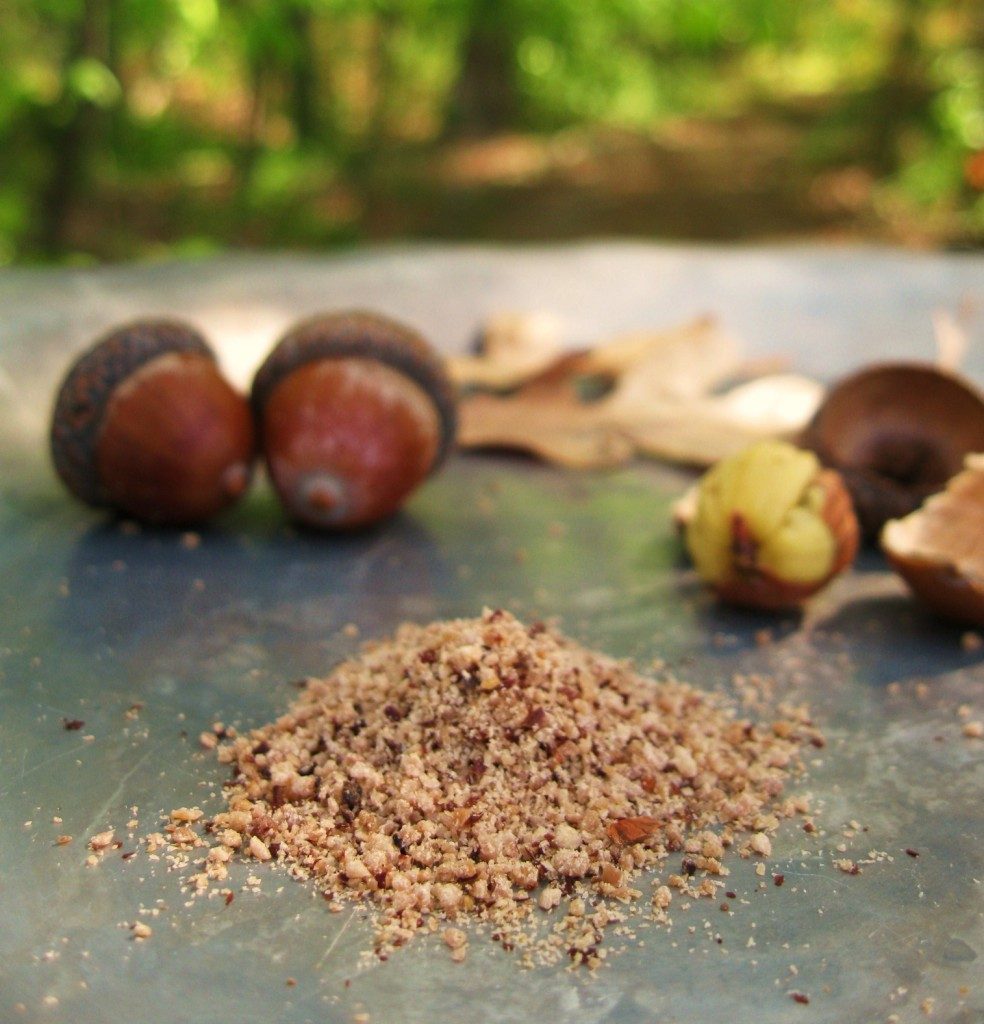
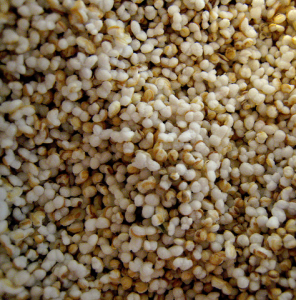
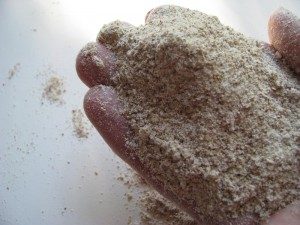
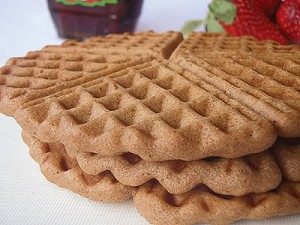
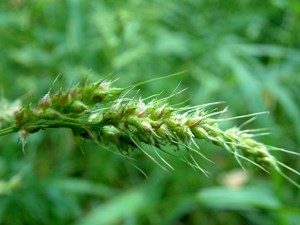
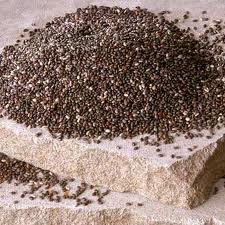
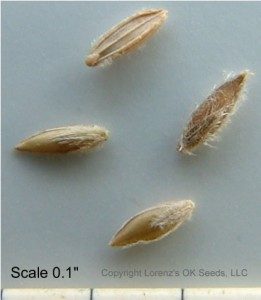
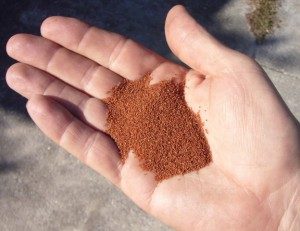
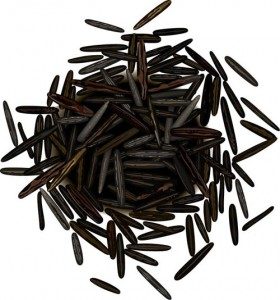
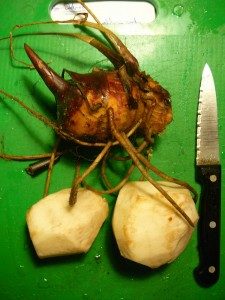
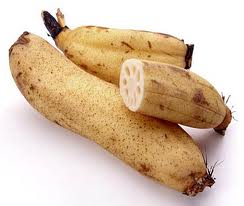
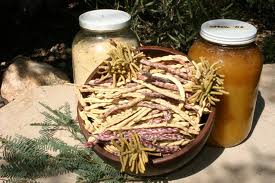
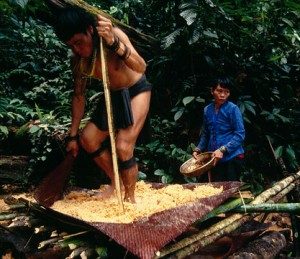
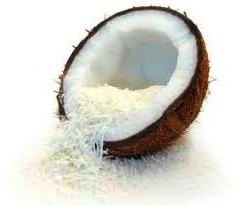
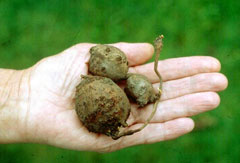
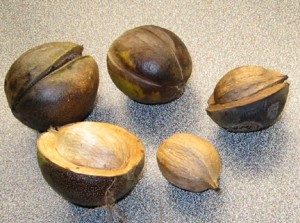
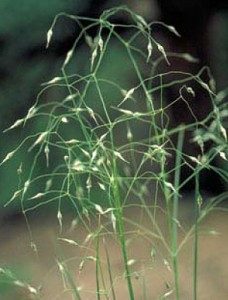
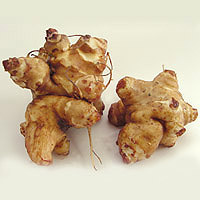
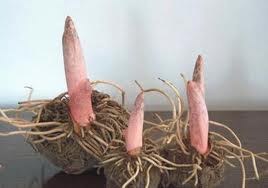
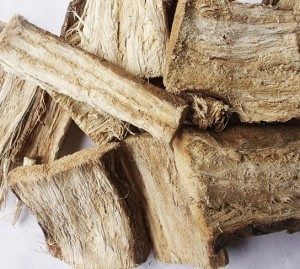
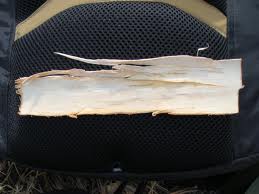
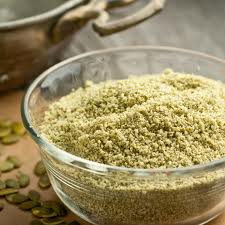
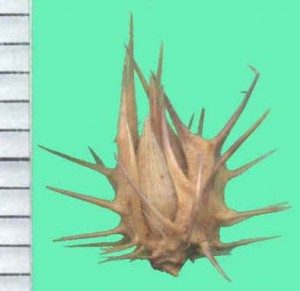
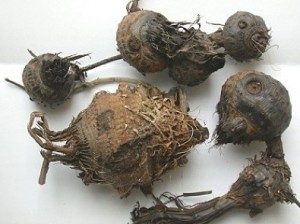
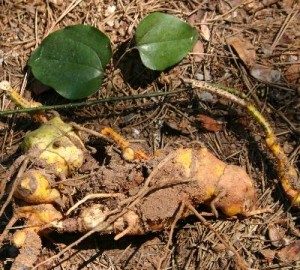
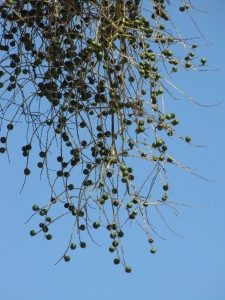
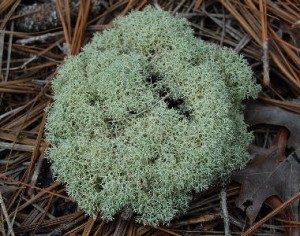
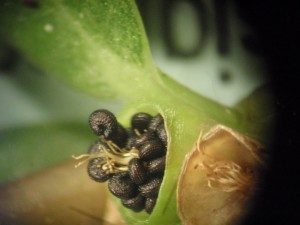

Green Deane the information you put out is amazing! Your site makes foraging research a whole lot less of a headache. Thank You!
can you refer to me any books or programs on plants in louisiana.
I sent you an email but it was not delivred. There is no book with pictures bu there is “Edible Plants of the Gulf South” by Charles Allen.
This is such an incredible post. Thank you
Deane, you are amazing! Great resource here, thank you.
Did you consider salsify root for a caloric staple?
I would also add that acorn flour is easy if you have the valley oak as we do here.
It doesn’t grow anywhere near here… likes cooler weather. I would view it as a caloric staple if I were in a cooler climate. Doesn’t make a flour per se.
On an earlier post, you mentioned that the Australian Aborigines make seed cakes from the minute seeds of purslane. I looked at my tiny crop of purslane and had to put my nose really close to see the “barrels” of little black seeds. I thought I might have an inferior strain of purslane, but I see in this post that even yourself has despaired of collecting significant quantities! In idle moments, I have often tried to imagine a dedicated aborigine cook collecting enough seeds for seed cakes, and it is similar to trying to imagine the size of the universe!
It depends on 1) how hungry you are and 2) how much purslane you have.
I saw no mention of dock seeds. Samuel thayer has said that they are edible, though unpalatable. But I was wondering if they wouldn’t be a good addition to your famine food section? Or is there some problem with them that I am unaware of? Anyways, excellent article, I always love your approach to these subjects.
Lets not forget kodo and finger millets, praspalum and erichloa species respectively. As for sandburs you’d do better to find the wild relative of foxtail millet (setaria species) those by the way are also related to sandburs (cenchrus species). Then there is wild maize or closer to home eastern gama grass (tripsacum dactyloides) both of which are progenitors of corn. Personally though I think that if you want to have flour you need to grow your own plants that are appropriate to your region and your needs. A wild plant is just one whose usefulness hasn’t been co-opted yet.
I found a recipe for leaching acorns. Crack , shell, remove skins and mash acorns. Put about 3/4 cup in a mason jar fill with water refrigerate over night pour off water and repeat about three times. Pound fine and mix with boiling water to make a gruel. To prepare amaranth or pigweed seeds, collect and winnow seeds( very easy) cook 1:30 minutes in microwave then grind in an electric coffee grinder. Amaranth flower makes a great gravy and with some bacon and acorn gruel a pretty good meal.
Great info but the Sunchoke, Jerusalem root etc converts some of the inulin into simple sugars in late winter that you can digest with less gas too:)
Konjac – AKA Corpse Flower amd many other names. I’d been googling this plant a lot for 0 calorie properties touted widely on the www. I came here and put just the first part of the scientific name to find this page. I could find no processing information other than what you have here. The ground corm(?) Is mostly indigestible fiber not starch. A great food for many reasons, but also good for weight loss not calories. Shirataki noodles are the “yam flour” made from the corm. More confusing yet is Tofu Shirataki in refrigerated organic foods section of Publix ( and others ) that list ingredients in the order water tofu , yam flour. Supposedly the tofu is added to make less rubbery noodles which otherwise are available dry, non-refrigerated 1 year shelf life. 8 oz package ( the water is dicarded and the noodles then rinsed ) seems to be an exceptionaly poor value. Tofu noodles are quite
Most usefull page I found on konjac so far is this one, the cofection mentioned is not very hard to find , it’s those large clear jars with a lot of clear plastic cups with foil lids around 1″ diameter, lychee and othet flavors. Sweetener may be sugar so check label for calories if trying to lose weight:
http://www.tofugu.com/2013/07/01/what-is-konnyaku/
I’ll tell you how the Aborigines made a meal of purslane. They’d pull up whole plants and dump them upside down on a sheet of bark. Go hunting and come back in a couple of days, and tthe seeds will have fallen out . Simply remove the dried plants, and winnow the seeds to clean them – can give a single meal of damper cooked in the coals. (I use the leaves in salads – lots of Omega 3 fatty acids in the leaves).
Also typha (cattails, bullrush, cumbungi) root was simply washed, roasted on coals, tied into a knot and chewed to get the starch out – tastes GOOD. Then undo knot and you have a fibre that wont rot in water – good for making fish trapping baskets.
Hi Deane,
Great article,
I live in Iceland and I am trying to get some calory/starch foods. Besides potatoes (the Icelandic staple starch) and grain, which is sometimes a bit on the difficult side, to ripen on our climate. So, potatoes, oats, and perhaps barley and rye.
We have lymegrass and silverweed growing wild, which I read could be starchy, but I haven´t tried them. Lymegrass is difficult to thrshed.
I am trying to grow groundnuts and crambe maritima, as two other sources, to be perennial, so there isn´t much effort to input, but so far I haven´t suceeded (will try to grow another species of crambe). I have jerusalem artichokes but although they grow super-fine they always fail to produce new tubers (since frost arrives in Sept). Maybe I should try cattails.
Would you recommend any other calory wild food to grow here, in a cold climate?
All true thistles have edible roots, that’s everyone in the genera Cirsium and Carduus.
Any information on preparing bamboo shoots to remove the cyanide-forming substances? Will simple boiling do it? I know a lot of fermented preparations are popular.
Boiling is a common method.
I have a severe nickel food allergy with gluten intolerance and can only eat white rice for a grain. I am looking for a food grade source for crab grass or any of the other healthy grasses on this site as a grain substitute. Contact me at timsbeach67@gmail.com
Tim Sipes
yeah what plants are good in Va , Nc Sc and Ga ? just curious as I know one can make a tea or even eat pine needles .
If one cooks beans and veggies and then dries it then they can grind up and make a flour too then take roses one can eat the flowers among other kinds of flowers [ go good in salads as well ] or dry them grind up make a flour ? I think there are many things one can make flour with that doesn’t take as much work as some of these do smiles . Food articles though so thanks .
I wanted to know if you can use saw palmetto roots to smoke foods??
Thank You!
As far as I know there isn’t anything toxic in the root but they smell quite bad when they burn. Not sure I’d food with that flavor.